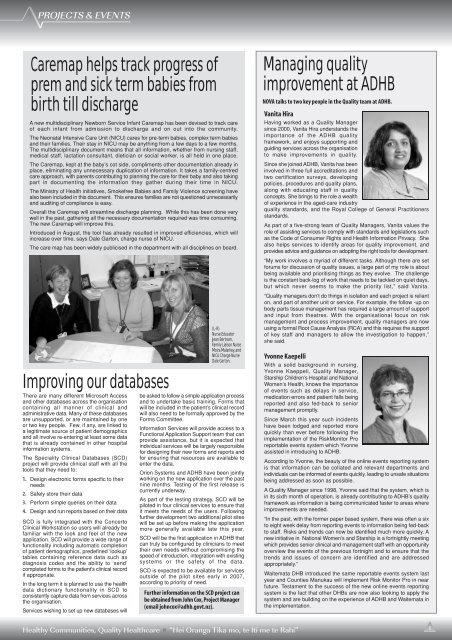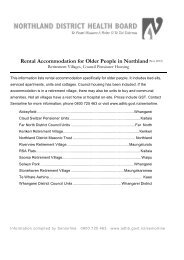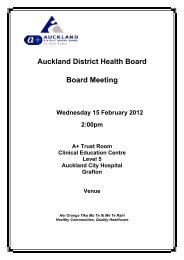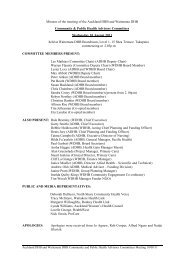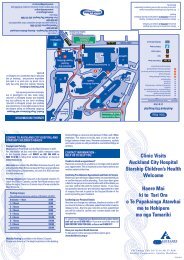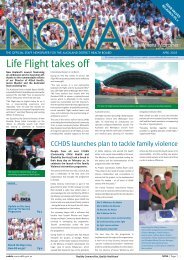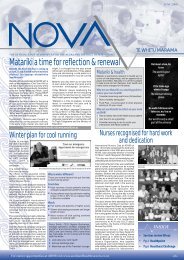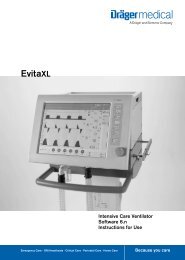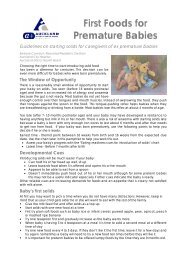NOVA - Oct.fh9 - Auckland District Health Board
NOVA - Oct.fh9 - Auckland District Health Board
NOVA - Oct.fh9 - Auckland District Health Board
You also want an ePaper? Increase the reach of your titles
YUMPU automatically turns print PDFs into web optimized ePapers that Google loves.
PROJECTS & EVENTS<br />
Caremap helps track progress of<br />
prem and sick term babies from<br />
birth till discharge<br />
A new multidisciplinary Newborn Service Infant Caremap has been devised to track care<br />
of each infant from admission to discharge and on out into the community.<br />
The Neonatal Intensive Care Unit (NICU) cares for pre-term babies, complex term babies<br />
and their families. Their stay in NICU may be anything from a few days to a few months.<br />
The multidisciplinary document means that all information, whether from nursing staff,<br />
medical staff, lactation consultant, dietician or social worker, is all held in one place.<br />
The Caremap, kept at the baby’s cot side, compliments other documentation already in<br />
place, eliminating any unnecessary duplication of information. It takes a family-centred<br />
care approach, with parents contributing to planning the care for their baby and also taking<br />
part in documenting the information they gather during their time in NICU.<br />
The Ministry of <strong>Health</strong> initiatives, Smokefree Babies and Family Violence screening have<br />
also been included in this document. This ensures families are not questioned unnecessarily<br />
and auditing of compliance is easy.<br />
Overall the Caremap will streamline discharge planning. While this has been done very<br />
well in the past, gathering all the necessary documentation required was time consuming.<br />
The new Caremap will improve this.<br />
Introduced in August, the tool has already resulted in improved efficiencies, which will<br />
increase over time, says Dale Garton, charge nurse of NICU.<br />
The care map has been widely publicised in the department with all disciplines on board.<br />
Improving our databases<br />
There are many different Microsoft Access<br />
and other databases across the organisation<br />
containing all manner of clinical and<br />
administrative data. Many of these databases<br />
are unsupported, or are maintained by one<br />
or two key people. Few, if any, are linked to<br />
a legitimate source of patient demographics<br />
and all involve re-entering at least some data<br />
that is already contained in other hospital<br />
information systems.<br />
The Speciality Clinical Databases (SCD)<br />
project will provide clinical staff with all the<br />
tools that they need to:<br />
1. Design electronic forms specific to their<br />
needs<br />
2. Safely store their data<br />
3. Perform simple queries on their data<br />
4. Design and run reports based on their data<br />
SCD is fully integrated with the Concerto<br />
Clinical Workstation so users will already be<br />
familiar with the look and feel of the new<br />
application. SCD will provide a wide range of<br />
functionality including automatic completion<br />
of patient demographics, predefined ‘lookup’<br />
tables containing reference data such as<br />
diagnosis codes and the ability to ‘send’<br />
completed forms to the patient’s clinical record<br />
if appropriate.<br />
In the long term it is planned to use the health<br />
data dictionary functionality in SCD to<br />
consistently capture data from services across<br />
the organisation.<br />
Services wishing to set up new databases will<br />
(L-R)<br />
Nurse Educator<br />
Jean Bertram,<br />
Family Liaison Nurse<br />
Moira Malarkey, and<br />
NICU Charge Nurse<br />
Dale Garton.<br />
be asked to follow a simple application process<br />
and to undertake basic training. Forms that<br />
will be included in the patient’s clinical record<br />
will also need to be formally approved by the<br />
Forms Committee.<br />
Information Services will provide access to a<br />
Functional Application Support team that can<br />
provide assistance, but it is expected that<br />
individual services will be largely responsible<br />
for designing their new forms and reports and<br />
for ensuring that resources are available to<br />
enter the data.<br />
Orion Systems and ADHB have been jointly<br />
working on the new application over the past<br />
nine months. Testing of the first release is<br />
currently underway.<br />
As part of the testing strategy, SCD will be<br />
piloted in four clinical services to ensure that<br />
it meets the needs of the users. Following<br />
further development two additional pilot sites<br />
will be set up before making the application<br />
more generally available late this year.<br />
SCD will be the first application in ADHB that<br />
can truly be configured by clinicians to meet<br />
their own needs without compromising the<br />
speed of introduction, integration with existing<br />
systems or the safety of the data.<br />
SCD is expected to be available for services<br />
outside of the pilot sites early in 2007,<br />
according to priority of need.<br />
Further information on the SCD project can<br />
be obtained from John Cox, Project Manager<br />
(email johncox@adhb.govt.nz).<br />
<strong>Health</strong>y Communities, Quality <strong>Health</strong>care “Hei Oranga Tika mo, te Iti me te Rahi”<br />
Managing quality<br />
improvement at ADHB<br />
<strong>NOVA</strong> talks to two key people in the Quality team at ADHB.<br />
Vanita Hira<br />
Having worked as a Quality Manager<br />
since 2000, Vanita Hira understands the<br />
importance of the ADHB quality<br />
framework, and enjoys supporting and<br />
guiding services across the organisation<br />
to make improvements in quality.<br />
Since she joined ADHB, Vanita has been<br />
involved in three full accreditations and<br />
two certification surveys, developing<br />
policies, procedures and quality plans,<br />
along with educating staff in quality<br />
concepts. She brings to the role a wealth<br />
of experience in the aged-care industry<br />
quality standards, and the Royal College of General Practitioners<br />
standards.<br />
As part of a five-strong team of Quality Managers, Vanita values the<br />
role of assisting services to comply with standards and legislations such<br />
as the Code of Consumer Rights and <strong>Health</strong> Information Privacy. She<br />
also helps services to identify areas for quality improvement, and<br />
provides advice and guidance on adopting the right tools for development.<br />
“My work involves a myriad of different tasks. Although there are set<br />
forums for discussion of quality issues, a large part of my role is about<br />
being available and prioritising things as they evolve. The challenge<br />
is the constant back-log of work that needs to be tackled on quiet days,<br />
but which never seems to make the priority list,” said Vanita.<br />
“Quality managers don’t do things in isolation and each project is reliant<br />
on, and part of another unit or service. For example, the follow -up on<br />
body parts tissue management has required a large amount of support<br />
and input from theatres. With the organisational focus on risk<br />
management and process improvement, quality managers are now<br />
using a formal Root Cause Analysis (RCA) and this requires the support<br />
of key staff and managers to allow the investigation to happen,”<br />
she said.<br />
Yvonne Kaepelli<br />
With a solid background in nursing,<br />
Yvonne Kaeppeli, Quality Manager,<br />
Starship Children’s Hospital and National<br />
Women’s <strong>Health</strong>, knows the importance<br />
of events such as delays in service,<br />
medication errors and patient falls being<br />
reported and also fed-back to senior<br />
management promptly.<br />
Since March this year such incidents<br />
have been lodged and reported more<br />
quickly than ever before following the<br />
implementation of the RiskMonitor Pro<br />
reportable events system which Yvonne<br />
assisted in introducing to ADHB.<br />
According to Yvonne, the beauty of the online events reporting system<br />
is that information can be collated and relevant departments and<br />
individuals can be informed of events quickly, leading to unsafe situations<br />
being addressed as soon as possible.<br />
A Quality Manager since 1998, Yvonne said that the system, which is<br />
in its sixth month of operation, is already contributing to ADHB’s quality<br />
framework as information is being communicated faster to areas where<br />
improvements are needed.<br />
“In the past, with the former paper based system, there was often a six<br />
to eight week delay from reporting events to information being fed-back<br />
to staff. Risks and trends can now be identified much more quickly. A<br />
new initiative in National Women’s and Starship is a fortnightly meeting<br />
which provides senior clinical and management staff with an opportunity<br />
overview the events of the previous fortnight and to ensure that the<br />
trends and issues of concern are identified and are addressed<br />
appropriately.”<br />
Waitemata DHB introduced the same reportable events system last<br />
year and Counties Manukau will implement Risk Monitor Pro in near<br />
future. Testament to the success of the new online events reporting<br />
system is the fact that other DHBs are now also looking to apply the<br />
system and are building on the experience of ADHB and Waitemata in<br />
the implementation.<br />
6


